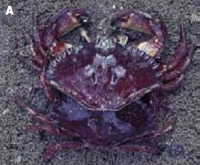SHRIMPS, CRABS, HERMITS, BARNACLES, SEA FLEAS, SEA SPIDERS AND OTHERS—Phylum ARTHROPODA
Including shrimps, crabs, hermits, sea fleas, fish lice, whale lice, isopods, pill bugs, barnacles, mites and sea spiders.
Its entire body encased in a chitinous (tough, protective) exoskeleton or shell, an arthropod must periodically moult or shed this protective covering so it may grow (see photograph A: red rock crab, AR98). Growth-induced moulting occurs more frequently in early life. Before a replacement cuticle hardens around the body, it swells with seawater, providing space for gradual tissue addition—as a child grows into a new pair of shoes.
Mobility is possible because of strategically placed joints where the exoskeleton is much thinner and more flexible. Segmentation is always present but only readily obvious in some species, and may be externally obscured in others by the carapace, a large shell element. However, the presence of paired antennae, mouthparts, pincer claws and walking legs always shows body divisions. In addition, segmentation is visible on the abdomen, whether extended as in shrimps or folded under as in crabs. In some species, such as the Dungeness crab (AR 101), the appearance of the abdomen is a secondary sexual characteristic. Photograph B shows a female (wider, beehive-shaped) on the left side and a male (longer, lighthouse-shaped) on the right.
Approximately 2,000 species of arthropods live in the marine waters of the Pacific Northwest.


Further Reading
Hart, Josephine, 1982, Crabs and Their Relatives of BC, British Columbia Museum Handbook #40, Victoria, BC. 267 pp.
Jensen, Gregory, 1995, Pacific Coast Crabs and Shrimps, Sea Challengers, Monterey, CA, 87 pp.
